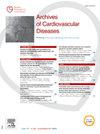Outpatient heart failure worsening in patients with cardiac transthyretin amyloidosis: Results from the Apollo-B trial
IF 2.3
3区 医学
Q2 CARDIAC & CARDIOVASCULAR SYSTEMS
引用次数: 0
Abstract
Introduction
Hospitalization is a significant clinical event in the progression of cardiac transthyretin (ATTR) amyloidosis, but not all patients (pts) who worsen become hospitalized. Outpatient oraldiuretic intensification or diuretic initiation (ODI) for heart failure (HF) has been shown to be prognostic of outcomes in pts with HFrEF or HFpEF
Objective
To assess the effect of patisiran on outpatient worsening of HF, characterized by ODI, and the prognostic utility of ODI in patients with ATTR-CM.
Method
This post hoc analysis of APOLLO-B (NCT03997383; comparing patisiran vs pbo in ATTR cardiomyopathy pts in a 12-month double-blind [DB] period followed by an open-label extension[OLE], in which all pts receive patisiran) assessed the effect of patisiran on ODI and a composite endpoint of all-cause mortality, cardiovascular (CV) events, and ODI by a win-ratio method.
Results
In APOLLO-B (combined DB and OLE with all remaining pts having reached Month 24 or later), for patisiran vs pbo (per initial treatment in DB), 61 (33.7%) vs 81 (45.5%) had outpatient ODI, 88 (48.6%) vs 93 (52.2%) had a CV event, and 19 (10.5%) vs 28 (15.7%) died. In Kaplan-Meier analysis, the probability of freedom from ODI was higher with patisiran vs pbo with separation of the two arms during the DB period (HR 0.694; 95% CI: 0.497–0.967) (Fig. 1). Patisiran was associated with a win ratio of 1.31 (95% CI: 0.97–1.75) on the composite endpoint, reflecting more favorable outcomes than pbo.
Conclusion
In APOLLO-B, worsening HF requiring ODI was significantly reduced by patisiran. Patisiran had a favorable effect on the combined risk of all-cause mortality, frequency of CV events, and ODI.
心脏转甲状腺蛋白淀粉样变患者门诊心力衰竭恶化:来自Apollo-B试验的结果
住院治疗是心脏转甲状腺素(ATTR)淀粉样变进展中的一个重要临床事件,但并非所有恶化的患者(患者)都住院治疗。门诊口服利尿强化或利尿起始(ODI)治疗心力衰竭(HF)已被证明是HFrEF或hfpef患者预后的预后因素。目的评估帕昔兰对以ODI为特征的HF门诊恶化的影响,以及ODI对ATTR-CM患者预后的作用。方法对APOLLO-B (NCT03997383;在为期12个月的双盲[DB]期间比较patisiran与pbo对ATTR心肌病患者的影响,随后进行开放标签扩展[OLE],其中所有患者均接受patisiran治疗),评估patisiran对ODI的影响以及全因死亡率、心血管(CV)事件和ODI的综合终点。结果在APOLLO-B(合并DB和OLE,所有剩余患者均达到24个月或更晚)中,对于patisiran和pbo(每次DB初始治疗),61(33.7%)对81(45.5%)有门诊ODI, 88(48.6%)对93(52.2%)有CV事件,19(10.5%)对28(15.7%)死亡。Kaplan-Meier分析显示,在DB期,两臂分离的pasiran患者与pbo患者免于ODI的概率更高(HR 0.694;95% CI: 0.497-0.967)(图1)。在复合终点,Patisiran与1.31 (95% CI: 0.97-1.75)的胜利比相关,反映出比pbo更有利的结果。结论在APOLLO-B组中,帕西兰显著降低了心衰恶化需要ODI的患者。Patisiran对全因死亡率、心血管事件频率和ODI的综合风险有良好的影响。
本文章由计算机程序翻译,如有差异,请以英文原文为准。
求助全文
约1分钟内获得全文
求助全文
来源期刊

Archives of Cardiovascular Diseases
医学-心血管系统
CiteScore
4.40
自引率
6.70%
发文量
87
审稿时长
34 days
期刊介绍:
The Journal publishes original peer-reviewed clinical and research articles, epidemiological studies, new methodological clinical approaches, review articles and editorials. Topics covered include coronary artery and valve diseases, interventional and pediatric cardiology, cardiovascular surgery, cardiomyopathy and heart failure, arrhythmias and stimulation, cardiovascular imaging, vascular medicine and hypertension, epidemiology and risk factors, and large multicenter studies. Archives of Cardiovascular Diseases also publishes abstracts of papers presented at the annual sessions of the Journées Européennes de la Société Française de Cardiologie and the guidelines edited by the French Society of Cardiology.
 求助内容:
求助内容: 应助结果提醒方式:
应助结果提醒方式:


